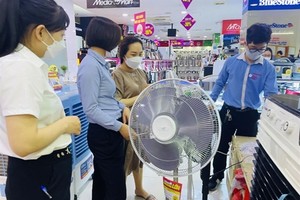
Vietnamese apparel manufacturers need to embrace the opportunities to meet the growing global fast fashion trends and from which to make breakthroughs, according to experts in the field of textile and garment.
After the fever of Zara, the local market once again exploded when Swedish budget apparel retailer H&M opened its outlet in Ho Chi Minh City. Recent arrival of international brands in Vietnam has quickly received a heartened welcome from customers meanwhile they make pressure on local firms increase.
Though they are moderate and budget fashion brands, Zara, H&M and Topshop are very attractive to young Vietnamese customers . Fast fashion is the practice of rapidly translating high fashion designs into low-priced garments and accessories by mass-market retailers at low costs. As fast fashion implies, styles no longer follow a four-season fashion calendar but a weekly one.
The story that young people in Ho Chi Minh City stood in a long queue showed the fever of cheap foreign commodities. This forces Vietnamese manufacturers to rethink how to retain their customers while more arrivals of foreign fashion brands will flood in Vietnam?
Do Huu Thanh - General director of Su Tu Vang firm specializing in unifom, said that new fashion trend refers to a phenomenon in the fashion industry whereby production processes are expedited in order to get new trends to the market as quickly and cheaply as possible. As a result of this trend, enterprises will face more challenge in design, order and delivery time .
Local firms have learnt much from foreign brands including winning the market by fast introduction of design. Vietnamese firms need to have good group of designers who can grasp the rapid changing lifestyle and consumers' choice for fashion and clothing in the market to fill the order.
To meet the demand and compete with foreign counterparts, local firms must step up investment in modern equipment and attract more skilled workers.
The Vietnam Textile and Garment Association (VITAS)'s deputy general secretary Nguyen Thi Tuyet Mai said the presence of foreign brands in Vietnam has both created pressures and impetus for changes of production and business. Accordingly, customers will have more choices.
Vietnamese firms have for long been familiar with outsourcing contracts for Foreign Direct Investment companies; but now, they have to make their own products to adapt to new trends.
The Association will help update the new trend in the globe for enterprises.
Saurav Ujjain, Southeast Asia business head at ThreadSol, a Singapore-based technology company in the apparel industry, presented its range of innovative solutions for Vietnam’s apparel industry such as correct purchases of fabric through intelloBuy to the most accurate planning to cut fabric through intelloCut, these solutions can help manufacturers boost revenues and profits. Averagely, IntelloCut helps producers to icnrease turnover to 30 percent with profits of $10 million each year.
























